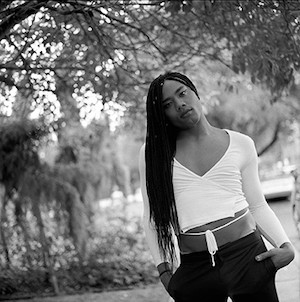Student Spotlight: Kiyan Williams ‘19
The Student Spotlight series aims to highlight the work of current MFA students, asking them to share thoughts on their practice by answering curated and peer-submitted questions.

Kiyan Williams '19 is a first-year Visual Arts MFA student.
What themes or subjects are you currently addressing in your work?
My art engages themes of history, memory, and black queer subjectivity. Some ideas that the work takes up include: legibility and illegibility, counterhegemonic history, and alternative ways of being and knowing.
I find dirt (soil) an extremely rich material to explore both my aesthetic and conceptual interests. Within white supremacist cis heteropatriarchal capitalism, dirt functions as a way to mark abject bodies. More specifically, dirt and dirtiness are invoked to pathologize and police Black bodies, queer bodies, poor folks, and bodies that deviate from normative constructs of identity. And yet, dirt/soil is an abundant, generative substance that supports and is foundational to all life. I’m using dirt/soil in my installation, sculpture, and performance work in order to layer some of these ideas.
I’m also working with unreleased video and essays from the archives of artist and scholar Marlon Riggs as material in my current work. Marlon Riggs’ seminal film Tongues Untied was the first of its kind to give voice to the experiences of Black gay men in America and aired on PBS in 1991. I’m using Marlon's archival material in order to honor and engage a legacy of Black queer cultural production, draw parallels between the past and present, and insert the lives of genderqueer and trans folks within discourses on Blackness.
Are there any themes or materials you’re interested in exploring in the future?
In the future, I’m very interested in explicitly exploring spirit as both an idea and material in my practice. By spirit, I'm referring to a transcendent, ecstatic, and effective experience that occurs in Black social spaces and community gatherings (I've witnessed it at church, the club, the street corner, barbecues, balls, etc). I think that spirit is central to Black struggles for freedom and self-determination.
What challenges do you face in your practice?
As a multidisciplinary artist working with various media I often struggle to figure out the best form for the ideas I’m interested in (rather haunted by), or how all of the media I’m creating will come together and inform each other. For most of my projects, I’ll create moving and still images, make sculptures, produce music, write text, and develop movement. All of these elements could exist on their own; however, for me, the purpose of creating the various components is putting them together in order to create a particular experience in time. Figuring out how to layer and arrange all of the components together can be challenging and takes time.
Who are artists or works of art that inspire you? Who are contemporary artists that are doing interesting work now?
The work of Marlon Riggs inspires my practice immensely. Marlon created a genre and method of art making that combined video, movement, experimental performance, and storytelling to explore ideas of identity and culture.
I’m also inspired by Ana Mendieta’s Untitled (Silueta Series), in which the artist creates sculptures using her body, earth, ocean, wood, and other organic materials.
Recent works that deeply inspired me include filmmaker Ja’Tovia Gary’s video An Ecstatic Experience in An Incomplete History of Protest at the Whitney Museum. The artist uses found footage in really profound and heartfelt ways that speak to Black people’s struggle for and commitment to freedom within persistent moments of systemic violence.
I was also deeply moved by artist Wu Tsang’s Girl Talk in the Trigger: Gender as a Tool and a Weapon show at New Museum. The video captures a very tender moment in which poet Fred Moten croons lyrics along the lines of, "we all have ups and downs," in a luscious, light-filled garden. I had very intense emotional responses to both videos, like ugly-crying in public. I’m inspired by art that makes me feel deeply about my complicated, precarious existence on this planet.
What has been your favorite class at Columbia so far?
I really enjoy our Visiting Artist Lecture Series, in which invited contemporary artists give talks about their practice. Highlights so far have been Renee Cox and Sondra Perry. I really appreciate being able to speak to, learn from, and connect with artists working in the world, especially Black artists living and working and creating really brilliant and courageous art under the particular social and political conditions we’re in.
How do you think artists can continue growing as artists?
For me, I think that I can continue growing as an artist by tending to my craft every day. All of my teachers and mentors have given me this advice. So much of my practice is ephemeral, and very little of what constitutes the totality of my creative practice gets shared publicly. For me, the art isn’t necessarily defined or limited by what I choose to share with others, but it’s all of the intimate, quiet, unremarkable things I do in solitude that nurture my practice and my spirit. It’s about practicing a certain kind of care and commitment to my ideas and my existence, believing that they deserve to take shape and form such that everyday I spend time tending to them.
